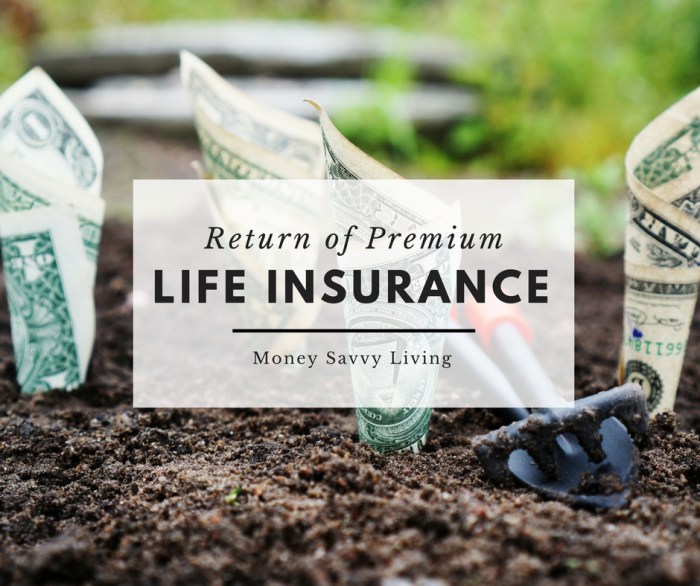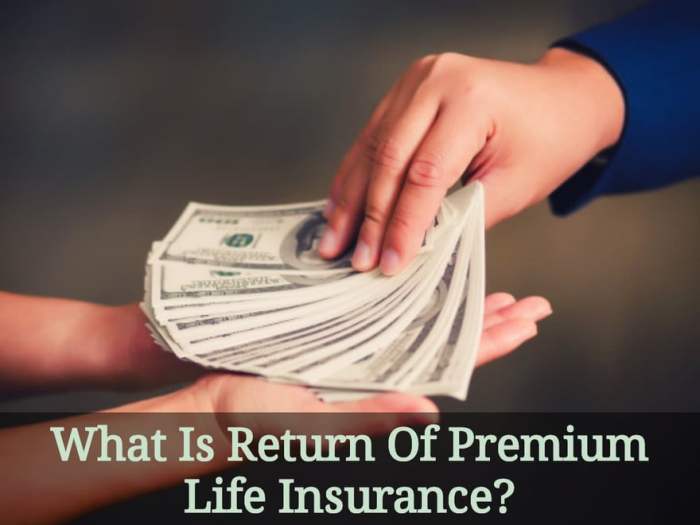Securing your family’s financial future is a primary concern for many, and life insurance plays a crucial role. However, traditional life insurance policies don’t always offer the flexibility or potential for a return on investment. Enter Return of Premium (ROP) life insurance, a unique type of policy that promises to return your premiums if you survive the policy term. This intriguing concept raises several questions: What are the conditions for receiving the return? How does it compare to other insurance options? This guide delves into the mechanics of ROP life insurance, providing clarity and insights into its workings.
We’ll explore the core features of ROP policies, comparing them to term and whole life insurance. We’ll analyze the factors influencing premium returns, including policy length and the insured’s age, and consider the potential tax implications. Through illustrative examples and a detailed FAQ section, we aim to equip you with the knowledge necessary to make informed decisions about this specialized type of life insurance.
Defining Return of Premium Life Insurance

Return of Premium (ROP) life insurance is a type of term life insurance policy that offers a unique benefit: the return of your premiums if you outlive the policy term. Essentially, you’re paying for life insurance coverage, but if you remain healthy throughout the policy’s duration, you get all your premiums back. This contrasts with traditional term life insurance, where premiums are paid but no money is returned if the insured survives the policy term.
Return of Premium life insurance policies are distinguished by their core feature: the guaranteed return of premiums paid. This is a significant difference from other life insurance options, such as whole life or universal life insurance, which may offer cash value accumulation but don’t guarantee a return of all premiums paid. The death benefit, the amount paid to beneficiaries upon the insured’s death, is also a key feature. While ROP policies offer a death benefit, the focus is often on the premium return, making it a more appealing option for those who prioritize financial security and want a safety net, without necessarily needing a substantial cash value component.
ROP insurance is most beneficial for individuals who want life insurance coverage for a specific period but also want a financial safeguard against premium payments without receiving any financial benefit if they outlive the policy. For example, a young professional might find this appealing during a period of high earning potential and family building, offering both protection and a return on investment if their family circumstances remain stable and they remain healthy. Another example would be someone who needs coverage for a specific mortgage term; this aligns the policy duration with the period of financial risk. Finally, someone focused on financial planning and investment might view ROP as a less risky alternative to other investment vehicles with similar time horizons.
Comparison of Life Insurance Policy Types
The following table compares Return of Premium life insurance with term and whole life insurance:
| Policy Type | Premium Return | Death Benefit | Cash Value |
|---|---|---|---|
| Return of Premium (ROP) | Guaranteed return of all premiums paid if the insured survives the policy term. | Payout to beneficiaries upon death of the insured during the policy term. | Generally, no cash value accumulation. |
| Term Life Insurance | No premium return if the insured survives the policy term. | Payout to beneficiaries upon death of the insured during the policy term. | No cash value accumulation. |
| Whole Life Insurance | No guaranteed return of premiums. | Payout to beneficiaries upon death of the insured, anytime. | Cash value accumulates over time, which can be borrowed against or withdrawn. |
Tax Implications of Return of Premium Life Insurance
Understanding the tax implications of return of premium (ROP) life insurance is crucial for prospective policyholders. While the policy offers the attractive feature of premium repayment, the tax treatment of these returned premiums can vary significantly depending on your location and specific policy details. This section will Artikel the key tax considerations associated with ROP life insurance.
Tax Treatment of Returned Premiums
The tax treatment of returned premiums under ROP life insurance policies is generally favorable in many jurisdictions. However, it’s essential to note that this is not universally true and depends heavily on local tax laws. In most cases, the returned premiums are considered a tax-free return of capital. This means that the money received back is not considered taxable income. This is because the premiums paid were initially considered non-deductible contributions. Therefore, the return of these premiums is simply a repayment of your initial investment. However, any accumulated interest or investment gains within the policy *may* be subject to taxation, depending on the specific policy structure and your jurisdiction.
Tax Treatment Variations Across Jurisdictions
The tax treatment of ROP life insurance can differ significantly between countries and even between states within a country. For instance, in the United States, the IRS generally treats the returned premiums as a non-taxable return of capital, as described above. However, specific state tax laws might vary, so it is important to consult with a qualified tax advisor to determine the precise tax implications in your specific state. Similarly, in Canada, the treatment is largely similar, but specific provincial regulations could have an impact. Other countries may have different tax codes and regulations, making it essential to seek professional tax advice tailored to your location.
Examples of Tax Scenarios
Consider two examples: First, a US resident, John, purchases a $100,000 ROP life insurance policy. Over ten years, he pays $10,000 in premiums. At the end of the term, if the policy performs as expected, John receives a $10,000 return of premiums. In most cases, this $10,000 is not considered taxable income by the IRS. However, any additional gains beyond the returned premiums would be taxable. Second, consider Maria, a Canadian resident, with a similar policy. The same principle applies, but she should consult her provincial tax authority to ensure compliance with provincial tax regulations. These examples highlight the importance of consulting with a tax professional to determine the specific tax implications based on your individual circumstances and location.
Potential Tax Considerations for Policyholders
Before purchasing a ROP life insurance policy, it’s prudent to consider several key tax implications:
- Taxability of Investment Gains: While the return of premiums is often tax-free, any investment gains generated within the policy may be subject to tax. This is particularly relevant if the policy has a cash value component.
- State/Provincial Tax Laws: Tax laws vary significantly between jurisdictions. Be sure to consult with a tax professional to understand the specific regulations in your location.
- Policy Structure and Features: The specific features and structure of the ROP policy can impact the tax treatment of the returned premiums. Some policies might have different tax implications than others.
- Reporting Requirements: You will likely need to report the receipt of the returned premiums on your tax return, even if it’s not taxable income. The specific reporting requirements vary by jurisdiction.
- Future Tax Law Changes: Tax laws can change over time. It’s important to stay informed about any potential changes that might affect the tax treatment of your ROP policy.
Choosing a Return of Premium Policy

Selecting the right return of premium (ROP) life insurance policy requires careful consideration of your individual needs and financial situation. It’s not a one-size-fits-all product, and understanding the nuances of different policies is crucial to making an informed decision. This section provides guidance on navigating the process of choosing a policy that best suits your circumstances.
Policy Comparison Across Insurers
Comparing ROP policies from different insurers involves analyzing several key aspects. Firstly, examine the premium rates offered by each company. While a lower premium initially seems attractive, consider the overall cost over the policy’s term. Next, carefully review the policy’s terms and conditions, including any exclusions or limitations on the return of premiums. Finally, research the financial stability and reputation of the insurer. A financially sound company is crucial to ensure your premiums are protected and your benefits are paid out as promised. For example, comparing quotes from three different insurers – say, Company A, Company B, and Company C – might reveal that Company A offers the lowest premium but has a less comprehensive coverage compared to Company B and C which may have slightly higher premiums.
Key Factors to Consider Before Purchase
Several crucial factors influence the suitability of an ROP policy. Your age and health significantly impact the premium rates. Younger, healthier individuals typically qualify for lower premiums. Your financial goals also play a vital role; ROP policies are best suited for those who want life insurance coverage with a guaranteed return of premiums. Consider your risk tolerance; ROP policies offer a degree of security, but it’s essential to weigh this against the potentially higher premiums compared to traditional term life insurance. Finally, your family’s financial needs and the level of coverage required should inform your decision. For instance, a young family with significant financial responsibilities might prioritize a higher death benefit, even if it means slightly higher premiums, whereas a single individual with fewer dependents might opt for a more affordable plan.
Essential Questions for Insurance Providers
Before committing to a policy, it’s essential to have a clear understanding of all its aspects. A checklist of questions to ask insurance providers includes inquiries about the specific return of premium conditions, the process for receiving the returned premiums, and any potential fees or charges associated with the policy. Clarification on the policy’s coverage, exclusions, and the insurer’s financial stability is also crucial. Additionally, understanding the policy’s renewability and portability options provides clarity on long-term flexibility. For example, asking about the specific conditions under which the premiums will be returned, such as whether it is a full return or a partial return based on specific conditions, ensures transparency and avoids any surprises later. Similarly, asking about the insurer’s financial ratings from agencies like A.M. Best or Moody’s helps assess the company’s stability.
Closure

Return of Premium life insurance presents a compelling alternative to traditional life insurance, offering a potential return on investment while still providing a death benefit. Understanding the nuances of ROP policies, including the conditions for premium returns, the influence of various factors, and the potential tax implications, is crucial for making an informed decision. By carefully weighing the advantages and disadvantages against your specific financial goals and risk tolerance, you can determine if a ROP policy aligns with your needs. Remember to consult with a qualified financial advisor to personalize your strategy.
FAQ Overview
What happens if I die before the policy matures?
Your beneficiaries will receive the death benefit, as with any life insurance policy. The returned premiums are irrelevant in this scenario.
Can I withdraw the accumulated premiums before the policy matures?
Generally, no. ROP policies are designed to return premiums at the end of the term, not allow for early withdrawals. Check your specific policy details for exceptions.
Does the return of premium affect my income tax?
The tax implications vary depending on your jurisdiction. Consult a tax professional to understand the tax treatment of returned premiums in your specific location.
What if I cancel my ROP policy before it matures?
You’ll likely receive a cash value, but it will almost certainly be less than the total premiums paid. The exact amount depends on the policy’s terms and the insurer’s surrender charges.
Are there any fees associated with ROP policies?
Yes, similar to other insurance policies, ROP policies may include administrative fees or other charges. Review the policy documents carefully.